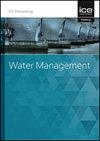底部出口两相流与进气涡的关系
IF 0.9
4区 工程技术
Q3 ENGINEERING, CIVIL
Proceedings of the Institution of Civil Engineers-Water Management
Pub Date : 2023-02-27
DOI:10.1680/jwama.21.00055
引用次数: 0
摘要
通过模型试验研究了竖井溢洪道底部出口在进水口空气涡旋的自然吸力作用下的气-水两相流的水力特性。实验是在一个直径2米、高1米的圆柱形水库中进行的,在入口周围的漩涡流下,研究了最严重的两相流状态。通过建立不同的涡旋类型,研究了三种不同直径和高度的垂直管道进气口,它们连接到水库中心的地板上,以检测不同的流量。本文讨论了主水库内切向速度分布、水头-流量关系、出口管内平均内压以及管道入口处旋流与底部出口内两相流的关系。结果表明,通过改变旋流形式,孔隙率降低。在一定的沉深条件下,减小进气管直径或增大进气管高度会导致空隙率和两相段塞流波弗劳德数、速度、长度和频率的增加。但随着科尔夫数的增加,段塞波频率降低,底部出口内平均相对两相流压力升高。底出口两相流水力特性和形态与进水口涡型之间的关系将引起科学研究和设计工程师的兴趣,有助于他们提高压力水道系统的效率和安全性。本文章由计算机程序翻译,如有差异,请以英文原文为准。
Relationship between two-phase flow in bottom outlet and air-core vortices at intake
Model experiments were carried out into the hydraulic characteristics of air−water two-phase flow inside the bottom outlet of shaft spillways as a result of natural air suction from air-core vortices at the pipe intake. Experiments were performed in a cylindrical reservoir 2 m in diameter and 1 m high, under a swirling flow around the intake, investigating the most severe two-phase flow regimes. Vertical pipe intakes with three different diameters and heights, attached to the floor of the reservoir at its centre, were examined for different flow discharges by establishing different vortex types. The results including tangential velocity profiles inside the main reservoir, head−discharge relationships, average internal pressure inside the outlet pipe and the relation between swirling flow at the pipe intake and the two-phase flow inside the bottom outlet are discussed in this paper. Results indicate that the void fraction decreases by changing the type of swirling flow. For a constant submergence depth, reducing the intake pipe diameter or increasing its height lead to an increase in void fraction and two-phase slug flow wave Froude number, velocity, length and frequency. However, by the increase in Kolf number, the frequency of slug waves reduced and the average relative two-phase flow pressure inside the bottom outlet was increased. The relationships between two-phase flow hydraulic characteristics and regimes inside the bottom outlet and types of vortices at the intakes will be of the interest of both the scientific research and design engineers, helping them increase the efficiency and safety of pressurised waterway systems.
求助全文
通过发布文献求助,成功后即可免费获取论文全文。
去求助
来源期刊
CiteScore
2.10
自引率
0.00%
发文量
28
审稿时长
6-12 weeks
期刊介绍:
Water Management publishes papers on all aspects of water treatment, water supply, river, wetland and catchment management, inland waterways and urban regeneration.
Topics covered: applied fluid dynamics and water (including supply, treatment and sewerage) and river engineering; together with the increasingly important fields of wetland and catchment management, groundwater and contaminated land, waterfront development and urban regeneration. The scope also covers hydroinformatics tools, risk and uncertainty methods, as well as environmental, social and economic issues relating to sustainable development.

 求助内容:
求助内容: 应助结果提醒方式:
应助结果提醒方式:


